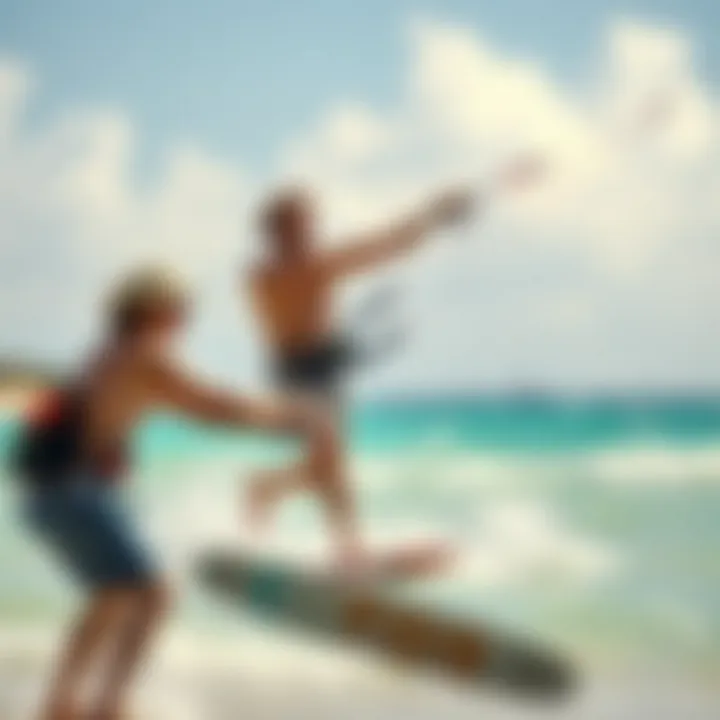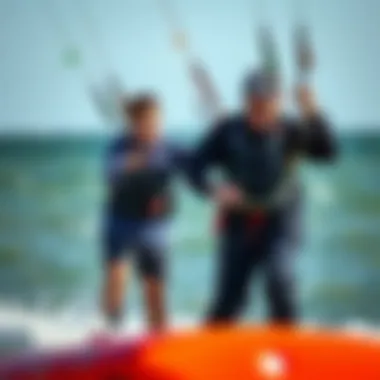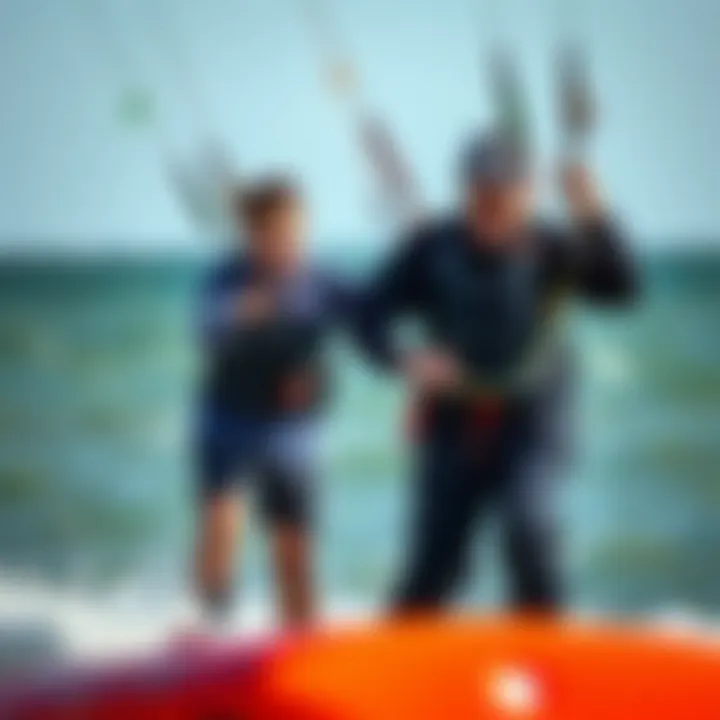Explore Kiteboarding Lessons Available Near You


Intro
Kiteboarding is more than just a sport; it's a thrilling blend of adventure and artistry that allows one to connect with the wind and waves. For those who are new to this exhilarating activity, finding the right lessons can feel like searching for a needle in a haystack, especially when you’re keen on safety and efficiency. The local scene can vary widely, with different schools offering distinctive approaches, methodologies, and vibes. What’s essential, however, is understanding what to look for in a course. This article aims to shine a light on the key aspects of kiteboarding lessons available in your area, helping enthusiasts navigate their choices with knowledge and confidence.
Gear and Equipment
When starting out in kiteboarding, having the right gear is paramount. It’s not just about looking good on the water; the equipment you choose can significantly impact your learning curve and overall enjoyment.
Essential Kiteboarding Gear for Beginners
In the world of kiteboarding, several key pieces of equipment are vital for beginners:
- Kite: This is your primary tool for harnessing the wind. For novices, a smaller kite is often recommended as it’s easier to handle.
- Control Bar: This bar connects you to the kite, allowing you to steer and control its power.
- Harness: Worn around your waist or hips, this piece of gear helps you transfer the kite's power to your body without using your arms constantly.
- Board: Your ride on the water, boards for beginners are designed to provide more stability and ease of use.
- Safety Leash: This connects you to the kite and is crucial for safety, ensuring you can quickly disconnect in an emergency.
Advanced Equipment for Experienced Riders
Once you become more comfortable on the water, you’ll want to expand your gear collection to enhance performance:
- Larger, Specialized Kites: As you gain skill, you'll often opt for larger kites suited for different wind conditions and styles.
- Different Board Types: Freestyle, freeride, or wave boards each tailor to specific styles of riding, enhancing maneuverability and speed.
- High-Performance Harnesses: More advanced harnesses offer greater support and comfort during intense sessions.
"Choosing the right gear is not just about function; it’s about finding what makes you feel connected to the water and wind."
Techniques and Tips
Mastering kiteboarding requires more than just getting used to your gear. Understanding techniques and adopting safety practices can be the difference between an enjoyable day on the water and a dangerous situation.
Safety Practices for Kiteboarding
Before diving in, absorbing some essential safety practices is crucial:
- Always Check the Weather: Being aware of wind patterns and conditions can prevent unexpected complications.
- Wear a Personal Floatation Device (PFD): While kiteboarding is an exhilarating activity, always wear a PFD for added safety.
- Buddy System: Try to kite with a friend; it’s not only safer but more enjoyable.
- Know Your Limits: Learning at your own pace is vital; don’t push yourself too far too fast.
Training Techniques to Improve Your Skills
As you embark on your kiteboarding journey, consider the following tips to sharpen your proficiency:
- Practice Basic Moves: Start with simple techniques, like controlling the kite in the air before progressing to board starts.
- Observe Skilled Riders: Watching experienced kiteboarders can unveil techniques and tips that aren't always taught.
- Engage in Land Drills: Familiarizing yourself with the equipment on land aids in transitioning to the water with confidence.
Finding the right kiteboarding lessons in your local area may seem daunting, but the insights provided here can guide you as you embark on this thrilling adventure. Whether you're standing at the water's edge for the first time or looking to sharpen your skills, the proper preparation and knowledge can help you achieve your kiteboarding aspirations safely and joyfully.
For more information on equipment and kiteboarding schools, consider checking out resources like Wikipedia or Reddit.
Understanding Kiteboarding
Kiteboarding, often hailed as one of the most exhilarating water sports, is not just about harnessing the wind and gliding across the waves. Understanding its intricacies is crucial for anyone looking to dive into this thrilling activity. It helps lay the groundwork for what's to come, whether you're a novice taking your first steps or someone experienced aiming to refine their skills.
Definition and History
At its core, kiteboarding combines aspects of surfing, paragliding, and windsurfing. The rider stands on a board that’s propelled by a large kite, which is controlled using a bar and lines. The sport has evolved significantly over the years, starting from humble beginnings in the late 20th century when enthusiasts began experimenting with kites and boards. One could trace it back to the late 1970s, but kiteboarding as we know it truly gained traction in the 1990s. The International Kiteboarding Organization was established in 2001, signaling an era of formalized progression and competitive events.
What was once seen as a daring pastime has now transformed into a global phenomenon, with competitions, festivals, and dedicated communities sprouting around the world. Understanding this rich history helps riders appreciate the sport's evolution and the pioneering spirit of those who came before them.
Benefits of Kiteboarding
Engaging in kiteboarding brings a multitude of benefits that extend beyond just the thrill of riding the waves. Notably, kiteboarding can enhance physical fitness. The sport does wonders for muscle tone and endurance. It engages your core, arms, and legs, giving you a well-rounded workout each time you hit the water.
Mentally, kiteboarding can be immensely rewarding. The concentration needed to master the techniques improves mental agility. This blend of physical and mental engagement can lead to a boost in overall confidence. Many people find that after a kiteboarding session, they not only feel physically invigorated but also mentally cleared, as if their worries have been whisked away by the wind.
Another significant perk is the chance to connect with nature. Being out on the water, feeling the wind, and experiencing the freedom of movement can be liberating.
In short, the understanding of kiteboarding encompasses its definition, history, and the numerous benefits it offers—ideas that are crucial for anyone considering entering this engaging world.
"Kiteboarding isn’t just flying a kite and standing on a board—it’s a symphony of wind, water, and personal growth."
For more information, visit sources like Wikipedia on kiteboarding, or engage with communities on forums like Reddit.
Importance of Lessons
Kiteboarding is not just about harnessing the wind and gliding across the waves; it's also a sport demanding respect, understanding, and solid foundational skills. The importance of lessons in kiteboarding cannot be overstated, primarily because they provide structured learning that helps individuals become competent and confident riders.
When diving into this adventurous world, many novice riders think they can learn through trial and error. However, this approach can lead to frustration, injuries, or even dangerous situations. Structured lessons pave the way for a safer, more enjoyable learning curve.
Reasons for Structured Learning
Structured learning builds a solid groundwork for any skill – kiteboarding is no exception. Here’s why considering lessons is crucial:


- Professional Guidance: Lessons are often led by experienced instructors who not only know the sport but also understand its intricacies. They can provide real-time feedback, ensuring that students correct mistakes early on, rather than developing bad habits.
- Safety First: With kiteboarding, understanding safety protocols is as important as mastering basic skills. Instructors cover what equipment is essential, how to use it properly, and how to respond to changing conditions.
- Faster Progress: A structured program allows learners to progress faster than self-taught methods. With a clear curriculum, students can build upon principles systematically, rather than piecing together skills sporadically. This leads to greater confidence and competence in a shorter timeframe.
"Learning under the guidance of an expert can turn a rough beginner into a skilled rider in no time."
- Building Techniques: Learning techniques in a controlled environment creates muscle memory. Lessons involve repetitive practices, ensuring that actions like launching and landing the kite become second nature.
- Community Connection: Engaging in lessons often means becoming part of a community. Meeting fellow riders opens doors to sharing experiences, tips, and camaraderie, enriching the entire learning journey.
Avoiding Common Pitfalls
Taking kiteboarding lessons also helps avoid common pitfalls that can impede progress or even deter individuals from the sport altogether. Here are pitfalls to be mindful of and how lessons can help steer clear:
- Injuries: Many self-taught individuals take unnecessary risks due to a lack of understanding about the complexity of equipment and unpredictable wind conditions. Lessons teach students how to mitigate risks and recognize the signs of dangerous conditions.
- Equipment Misuse: Newbies often struggle with setting up and using equipment improperly. Instructors provide hands-on training, which reduces the chances of major errors.
- Environmental Conditions: Understanding wind patterns is crucial. New riders may not consider how the wind interacts with the surrounding landscape. Lessons can illuminate how to read conditions effectively.
- Equipment Overload: Some eager learners jump into buying expensive gear without understanding their specific needs. Lessons help students learn what equipment suits their skill level and local conditions, preventing unnecessary expenses.
In summary, kiteboarding lessons play a vital role — not just in teaching techniques, but also in fostering safety, progress, and community. As one embarks on this thrilling pursuit, taking the time to invest in proper instruction can ultimately enhance both the learning experience and overall enjoyment of the sport.
Types of Kiteboarding Lessons
Understanding the various types of kiteboarding lessons available is crucial for anyone looking to dive into this thrilling sport. Each approach offers its unique advantages, catering to different learning styles and preferences. Choosing the right type of lesson can significantly affect your progression and overall experience on the water. Here’s a detailed look at the three primary types of kiteboarding lessons: private lessons, group lessons, and online instruction.
Private Lessons
Private lessons provide a tailored instructional experience, ideal for individuals who prefer a one-on-one environment. In this format, you and the instructor can focus intensively on your specific needs and skill level. This setting can accelerate the learning process, allowing for immediate feedback and adjustments in real-time.
Some benefits of private lessons include:
- Personalized Attention: The instructor's sole focus is on you, which ensures customized guidance tailored to your abilities.
- Flexible Scheduling: You have the freedom to choose lesson times that work best for you, making it easier to fit kiteboarding around your lifestyle.
- Quick Progression: With personalized instruction, many students find they can progress faster than in group formats.
However, consider this option if you’re prepared for the costs associated, as private instructions can be more expensive compared to group lessons. Also, it might be a bit odd if you're accustomed to learning in social settings. But the concentrated focus often yields rewarding results.
Group Lessons
Group lessons are another popular avenue for learning kiteboarding, offering the chance to connect with others while developing your skills. Typically, these sessions range from two to several students, guided by an instructor. This format fosters a supportive and engaging atmosphere, making it popular among beginners.
Key points to ponder when considering group lessons include:
- Cost-Effectiveness: Group lessons tend to be more affordable than private sessions, making them an appealing option for recreational riders or those just starting out.
- Social Interaction: Learning alongside other kiteboarders can create camaraderie, making the lessons enjoyable and less intimidating.
- Shared Learning Experiences: Watching peers struggle or succeed can aid in your understanding and retention of skills.
On the flip side, the downside might be the varied skill levels within a group, which can lead to uneven learning experiences. Those who need extra assistance may find they aren’t receiving the individualized support necessary.
Online Instruction
In this digital age, online instruction is a growing trend in kiteboarding education. While it cannot completely replace hands-on experience, it serves as a helpful resource to complement your lessons. Many kiteboarding schools and instructors offer video tutorials, webinars, and online courses that cover various topics such as:
- Technique and Fundamentals: Basics like how to set up your gear, understanding wind angles, and mastering body movement.
- Advanced Tactics: Sessions that delve deeper into tricks, technique refinement, or even video analyses of your performance.
- Safety Guidelines: In-depth discussions on safety protocols, which are vital to a successful kiteboarding experience.
The benefits of this type of learning include flexibility in lessons, allowing for self-paced study and more time spent reviewing material. On the other hand, it lacks the immediate feedback and hands-on practice offered by in-person lessons. This format may not be well suited for those who thrive in an engaged, physical learning environment.
The type of kiteboarding lesson you choose can depend on various factors such as your learning style, budget, and availability. Make a decision that resonates with you; whatever path you take, making a commitment to learning safely and effectively will help you progress in your kiteboarding journey.
Finding Lessons Near You
Finding kiteboarding lessons in your locality can be likened to searching for a hidden gem. Kiteboarding, while thrilling, requires the right guidance, especially for newcomers. Knowing where to seek lessons is an essential step towards embarking on this exciting journey. Local schools not only provide access to instructors but also help you familiarize yourself with your natural environment. This immersion is key, as local spots can have unique challenges that experienced instructors can help navigate.
Searching for Local Schools
When it comes to searching for kiteboarding schools nearby, the process is much easier now than it used to be. The advent of online resources and community forums has changed the playing field entirely. Websites like Facebook or Reddit often have dedicated groups where local kiteboarding enthusiasts share their experiences and recommend schools. Moreover, visiting websites that aggregate water sports schools can unveil a list of certified instructors. You may not even need to look very far. Consider using search phrases such as "Kiteboarding lessons near me" or exploring keywords like "kiteboarding instruction [yourlocation]" in Google.
"The best way to learn is to dive into it with someone who knows the ropes—literally and figuratively."
While searching, make sure to check for the school’s physical presence and reviews from previous students. User-generated content on platforms like Yelp or TripAdvisor can provide invaluable insight into the reputation of the school, the quality of instruction, and the level of customer service. Often, a great instructor can make a world of difference, turning an intimidating learning experience into an exhilarating one.
Evaluating Teaching Credentials
Once you identify potential schools, evaluating the instructors’ credentials becomes paramount. Not every kiteboarder can teach effectively; it requires patience, understanding, and the ability to break down complex skills into manageable parts. Look for instructors certified by reputable organizations like the International Kiteboarding Organization (IKO) or the British Kite Sports Association (BKSA). These certifications suggest that the instructors have undergone rigorous training themselves and are well-versed in safe practices.
Additionally, don’t shy away from asking questions. The right instructor should not only be passionate about the sport but also open to discussing their qualifications and experiences. Inquire about the number of years they've been teaching and their approach to safety, skill-building, and even personality traits. Can they explain concepts clearly? Do they exhibit enthusiasm? Capturing insights about their coaching style can inform whether you will connect with them.
Understanding Lesson Regulations
Understanding the regulations surrounding kiteboarding lessons is critical, especially for newcomers. Regulations can vary significantly from one area to another, often determined by local authorities or riding locations. Some beaches may require permits to kiteboard, while others may have designated areas for beginners and advanced riders alike.
Additionally, it's prudent to check if there are any restrictions related to weather conditions or peak times. Engaging with local schools can often provide clarity about these regulations, ensuring you're not only learning effectively but doing so in compliance with local laws. Some regions may even mandate the use of helmets and other protective gear during lessons.
What to Expect in Lessons
Engaging in kiteboarding lessons is akin to taking a deep dive into the ocean—you're not just learning to paddle; you're understanding the currents, the wind, and the rhythm of the sport itself. This segment sheds light on what you can expect from your kiteboarding lessons. Breaking down the structure helps not only in comprehension but also in setting realistic expectations for your learning journey.


Initial Assessment
Upon your first lesson, be prepared for an initial assessment. The instructor will gauge your comfort level, previous experience, and physical abilities. This step is essential because it shapes your personalized learning path. If you're a seasoned adventurer or a novice eager to get your feet wet, your instructor will tailor the approach accordingly.
For example, a beginner may require more time on the basics, such as body positioning and stability, while someone with prior experience might swiftly move onto mastering maneuvers. This assessment is not merely procedural—it’s a way to ensure that you receive the most effective training that suits your unique strengths and weaknesses.
Equipment Familiarization
Next on the agenda is equipment familiarization. You’ll be introduced to the kite, board, harness, and other essential gear. Understanding the role of each piece of equipment is vital for safety and performance. Your instructor will explain how to assemble the kite, perform checks for safety, and properly attach your harness.
- Kite: It brings the lift needed to get you airborne.
- Board: It’s your foundation on the water.
- Harness: Connects you to the kite, distributing the load evenly.
- Safety Gear: Helmets, impact vests, and safety systems are crucial for protection.
Being acquainted with your gear builds confidence, allowing you to focus on technique rather than battling uncertainty. Also, you might learn a few maintenance tips—being able to spot wear and tear or knowing when to store your equipment properly can prolong its life.
Basic Skills Development
After assessing and familiarizing yourself with the equipment, you will dive into basic skills development. This phase is where the real fun begins. Expect to learn fundamental skills like how to launch and land the kite, controlling its power, and basic navigation. These skills form the backbone of your kiteboarding competence.
During the lessons, you might encounter:
- Body Dragging: Mastering how to control the kite while being pulled through the water.
- Board Starts: Learning to get up on the board from a non-boarded position.
- Riding Upwind: This is vital as it allows you to return safely to your starting point after a run.
Each of these skills require practice and patience. It's not uncommon to feel like you’re learning to walk again, but with steady guidance and supportive feedback from your instructor, you will likely see noticeable improvements from one lesson to the next.
"Kiteboarding is a dance with the wind, and lessons are your choreographer."
By knowing what to expect in kiteboarding lessons, you prepare yourself mentally for the journey ahead. An initial assessment aligns your expectations, equipment familiarization builds confidence, and foundational skills development sets the stage for more advanced maneuvers down the line. Each step is a building block, ultimately leading you to a fluid, exhilarating experience on the water.
Safety Considerations
When it comes to kiteboarding, safety isn't just a suggestion—it's a crucial component that can make or break the experience. Understanding the principles of safety can safeguard not only your well-being but also enhance your ability to learn and progress in this exhilarating sport. Kiteboarding can be thrilling, but the very elements that make it exciting can also pose significant risks if not managed correctly. From mastering the use of safety equipment to being aware of the impact of wind conditions and knowing what to do in emergencies, it's essential to cover all bases.
Essential Safety Gear
Before you even think about hitting the water, make sure you have the right safety gear. The equipment you choose can significantly influence how safely you can ride. Below are key items every kiteboarder should have:
- Helmet: Protects your head from impacts, whether from falling or collisions.
- Impact Vest: Cushions falls and offers some buoyancy, making it easier to stay afloat.
- Life Jacket: Although not always mandatory, it’s a smart choice for added safety, especially in open water conditions.
- Wetsuit: Helps maintain body temperature and can protect against scrapes if you fall.
- Safety Release System: This is crucial for detaching the kite in emergencies, allowing you to regain control quickly.
Having the right gear allows you to focus on learning without the cloud of anxiety looming over you—after all, it's much more enjoyable to ride worry-free.
Understanding Wind Conditions
Wind conditions are at the heart of kiteboarding, determining whether conditions are right or risky for a session. This is not just about checking the weather; it requires a nuanced understanding of how various factors can affect your ride.
Key Aspects to Consider:
- Wind Speed: Ideally, you'll want wind speeds in the range of 15-25 knots for beginners. Anything too light won't keep your kite in the air, while winds exceeding 25 knots can be daunting and should be avoided.
- Wind Direction: Know where the wind is coming from. Cross-shore winds are often preferable as they maintain a safe distance from the shore during emergencies.
- Local Topography: Hills and buildings can create wind turbulence. Familiarizing yourself with your local launch spots can save you a lot of headaches— and potentially, injuries.
Learning how to read wind conditions comes with practice. You can’t just rely on your phone’s weather app; instead, try to observe patterns and how they affect you and others on the water.
Emergency Procedures
The kiteboarding environment can change in the blink of an eye. Knowing how to react when something goes wrong is as important as the skills you develop in lessons. Instructors will often cover emergency procedures, but having a personal grasp of these can prepare you to face unexpected situations confidently.
Key Emergency Procedures to Know:
- Executing a Self-Rescue: If your kite becomes unmanageable, understanding the self-rescue technique can be a lifesaver. It typically involves detaching your kite and using it as a flotation aid.
- Using Your Safety Release: This should be your first response to take control of a runaway kite. Make sure you practice how to use this system during lesson hours.
- Creating a Signal: If you find yourself in a bind, signaling nearby riders or lifeguards can attract attention quickly. Simple flags worn on your vest can communicate emergencies.
Being prepared isn’t just about keeping safe—it’s about enjoying the ride without worry.
In essence, understanding these safety considerations makes a remarkable difference in the kiteboarding experience. Prioritize safety gear, grasp wind conditions, and know your response methods, and you’ll be well on your way to a rewarding journey on the water.
Evaluating Your Progress
Evaluating your progress in kiteboarding is not just an afterthought; it’s a crucial component of your learning journey. This phase allows you to assess both your technique and your comprehension of the sport. Regular reflection on your development can significantly boost your motivation and provide clarity on areas that require further improvement. Tracking how far you've come enables you to celebrate victories, however small they may be.
Setting Achievable Goals
Setting achievable goals is key in kiteboarding. Without targets, your learning can drift aimlessly, much like a kite without a wind to catch. You might ask, how do you set these goals? Well, start by breaking down your overall ambition into smaller, manageable milestones. For instance, if you're aiming to master jumping, focus initially on basic skills like controlling the kite in the air or getting comfortable with the board.
To make your goals even more effective, consider using the SMART criteria: Specific, Measurable, Achievable, Relevant, and Time-bound. For example, instead of saying, “I want to get better at kiteboarding,” try “In the next month, I’ll practice jumping for at least two hours every week.” This not only gives clarity but also makes it easier to track your progress.
Tracking Skill Development
As you pursue your kiteboarding goals, tracking your skill development becomes increasingly important. It’s all well and good to have aspirations, but how do you know when you’ve reached them? Keeping a journal or a digital log can be a simple yet effective way to record your progress. You can jot down things like the kites you've used, techniques learned, and personal reflections on each session.


Moreover, video documentation can serve as an extra pair of eyes. Watching yourself ride can reveal details that you might overlook in the heat of the moment. Through this, you can spot strengths and weaknesses, thus making your practice time much more focused and effective.
Connecting these evaluations with your goals allows you to adjust your learning path. If a particular aspect proves too challenging, it might be necessary to refine your approach. Furthermore, sharing your experiences with fellow kiteboarders can open up avenues for constructive feedback. Community and discussions not only provide support but also elevate your understanding of the sport.
Regularly evaluating your progress not only enhances your skills but also strengthens your connection to the kiteboarding community.
By methodically setting goals and tracking skills, you’re equipping yourself to ride the winds with confidence and finesse. So, gear up and get ready to dive into the exhilarating world of kiteboarding, one measured step at a time.
Community and Networking
Engaging with the kiteboarding community is a pivotal aspect of developing as a rider. It goes beyond just mastering the mechanics of the sport. Establishing connections with fellow enthusiasts can significantly enhance your learning experience and overall enjoyment of kiteboarding. It creates a supportive environment in which both novice and experienced riders can thrive.
Connecting with Fellow Riders
One of the most significant benefits of connecting with fellow riders is the wealth of knowledge shared within these circles. By mingling with others who share your passion, you gain access to tips, tricks, and insights that you might not find in any instructional manual. You might realize that others have faced similar challenges and can provide guidance on how to overcome them.
- Finding Your Tribe: It’s reassuring to know there are others on the same journey. Local meet-ups or online forums provide an excellent platform to communicate. Websites like reddit.com/r/kiteboarding can be gold mines for guidance on local spots, gear recommendations, or simply finding someone to hit the waves with.
- Learning Together: Group dynamics can offer unique perspectives on skill development. Some riders flourish in social settings, learning faster with peers who motivate them. When you practice alongside others, you can critique each other’s techniques, fostering improvement in a relaxed atmosphere.
- Safety in Numbers: Kiteboarding, especially in remote areas, can come with its hazards. Riding with others not only promotes a sense of camaraderie but also enhances safety. You can look out for one another, ensuring that help is readily available if someone gets into a sticky situation.
Participating in Local Events
Attending local kiteboarding events can be an exhilarating way to deepen your connection with the sport and its community. Competition and collaborative events allow riders to showcase their skills while interacting with others. These gatherings often include various activities that cater to all skill levels.
- Competitions and Workshops: Engaging in events, whether as a competitor or spectator, fuels the competitive spirit. Witnessing skilled riders conquer new tricks can reignite your passion for kiteboarding. Many local schools often host workshops, providing attendees with hands-on experience and direct feedback from instructors.
- Beach Clean-ups and Fundraisers: Getting involved in community-focused initiatives not only strengthens ties but promotes environmental stewardship. Events focused on preserving the beach areas where you ride can resonate with your love for the sport, making you feel more connected to your local riding spots.
- Socializing and Networking: Local events are prime opportunities to make relationships that may influence your kiteboarding journey. Meeting experienced riders can lead to mentorship opportunities or even partnerships for private lessons.
"In the community, you don’t just ride; you grow. The connections forged in our shared passion build a bridge between skill and experience."
In summary, actively engaging with the kiteboarding community facilitates personal and technical growth. The camaraderie formed by connecting with fellow riders and participating in local events creates a supportive network that is invaluable. As you immerse yourself in this vibrant community, you’ll find that both your skills and your enjoyment of kiteboarding can reach new heights.
Resources for Continued Learning
As with any sport, kiteboarding thrives on continuous improvement and skill development. After initial lessons, engaging with ongoing resources can ensure that you not only maintain but also expand your abilities on the water. Keeping your skill set sharp is crucial, especially in a sport as dynamic as kiteboarding where conditions and techniques evolve.
Accessing additional learning materials provides several benefits. For instance, experienced kiteboarders can review new maneuvers, understand advanced techniques, or even brush up on safety protocols. Further, resources often come with the added context of expert tips or community feedback, making them a valuable addition to your training. Here’s what to consider when exploring these resources:
- Diverse Learning Formats: Different mediums cater to varied learning styles. Some people grasp concepts better through videos, while others prefer in-depth tutorials.
- Access to Latest Techniques: Kiteboarding is not stagnant; it evolves. Regular updates from professionals can keep you ahead of the curve.
- Networking Opportunities: Engaging with online communities or attending in-person workshops can give you a chance to connect with other kiteboarders, opening doors to new friendships or potential riding partners.
Online Tutorials and Videos
The internet is a treasure trove of resources, especially for visual learners. Online tutorials and videos offer a vast array of demonstrations and instructions from both seasoned experts and enthusiastic amateurs. By checking platforms like YouTube or specialized kiteboarding websites, you can find everything from introductory lessons to advanced movements. Here are a few considerations:
- Variety of Content: Topics range from basic kite setup to complex tricks, so you can always find resources relevant to your current skill level.
- Free vs. Paid Content: Many creators offer free videos, but platforms like Vimeo or subscription services may provide high-quality content that is more structured.
- Engagement with the Instructor: Watching an instructor in action can clarify complex techniques that might be difficult to grasp through textual instruction alone.
Suggested platforms:
- YouTube for diverse video content.
- Kiteboarding.com for dedicated tutorials and specific technique videos.
- Reddit has various threads where kiteboarders discuss innovative techniques and learning resources.
Advanced Clinics and Workshops
For those who have already dipped their toes into kiteboarding, advanced clinics and workshops can be incredibly fruitful. These settings often provide hands-on instruction with immediate feedback—a critical element for mastering skills. Attending clinics can come with certain perks, such as specialized equipment access and tailored coaching:
- Expert Insights: Learn from industry professionals or top competitors who bring a wealth of experience and can provide secrets to refining your performance.
- Focused Training: Unlike a general lesson, workshops can concentrate on specific skills or trick progression.
- Community Feedback: Engaging with peers at workshops can lead to useful discussions about personal challenges and breakthroughs in technique.
Recommendations for finding clinics include checking with local kiteboarding schools, exploring regional competitions, or visiting community bulletin boards often found via social media or specific online forums. Some notable sites to explore include:
- Facebook for local group events and clinics.
- Local establishments often post flyers or updates on Meetup related to kiteboarding activities.
- The Kiteboarding Association follows certifications and professional workshops.
In summary, continued learning resources can be the wind at your back on your kiteboarding journey. Embrace them, and you may find yourself quickly flying high.
Finale
When diving into the world of kiteboarding, it's crucial to understand that lessons aren’t just about learning to ride the waves; they encompass a vast array of factors that contribute to both enjoyment and safety. The conclusion of this expedition into kiteboarding lessons ties the elements discussed throughout the article into a cohesive understanding.
Recap of Key Points
First and foremost, proper instruction is invaluable. Having a knowledgeable instructor not only ensures that one learns the fundamental techniques effectively, but it also significantly minimizes risks associated with the sport.
- Structured Learning: Engaging in structured classes, whether private, group, or online lessons, helps build a strong foundation.
- Safety Measures: Understanding and utilizing safety gear correctly is a must for everyone, regardless of skill level.
- Community Connection: The kiteboarding community brings both camaraderie and support, enhancing the overall experience.
- Ongoing Evaluation: Regularly evaluating one's skills and progress can keep riders motivated and help identify areas for improvement.
Every kiteboarder should take to heart that kiteboarding is as much about the journey as it is about the thrill of gliding across water. By emphasizing key principles of safety and proper instruction, the article highlights a pathway to a rewarding and exhilarating adventure.
Encouragement for Continued Practice
As you step away from your first lesson or finish your latest adventure on the water, remember that practice is where the magic happens. Kiteboarding isn't just learned in a classroom or during sanctioned lessons. Every outing, every ride, contributes to your proficiency and self-assurance on the board. Join local events, connect with seasoned riders, and don't shy away from participating in workshops.
The wind and water can be temperamental. Don't let a few rough patches discourage you. Instead, view challenges as opportunities to grow. Set goals for yourself, celebrate small milestones, and keep building up your skills. There’s a saying among kiteboarders: "Every session is a lesson." Embrace that philosophy, and you'll find yourself evolving not just as a rider, but as part of an exhilarating community.
Finally, as you get swept away by the waves and the joy of kiteboarding, never forget that every great kiteboarder was once a beginner, just like yourself. So grab your gear, seek out those lessons, and let the wind take you on thrilling adventures.
"The sea is calling and I must go." - John Muir
For further reading on kiteboarding tips and community events, check out Wikipedia on Kiteboarding and engage with fellow kiteboarders on Reddit.
You might also find forums on Facebook helpful for connecting with local riders and learning about upcoming events.



